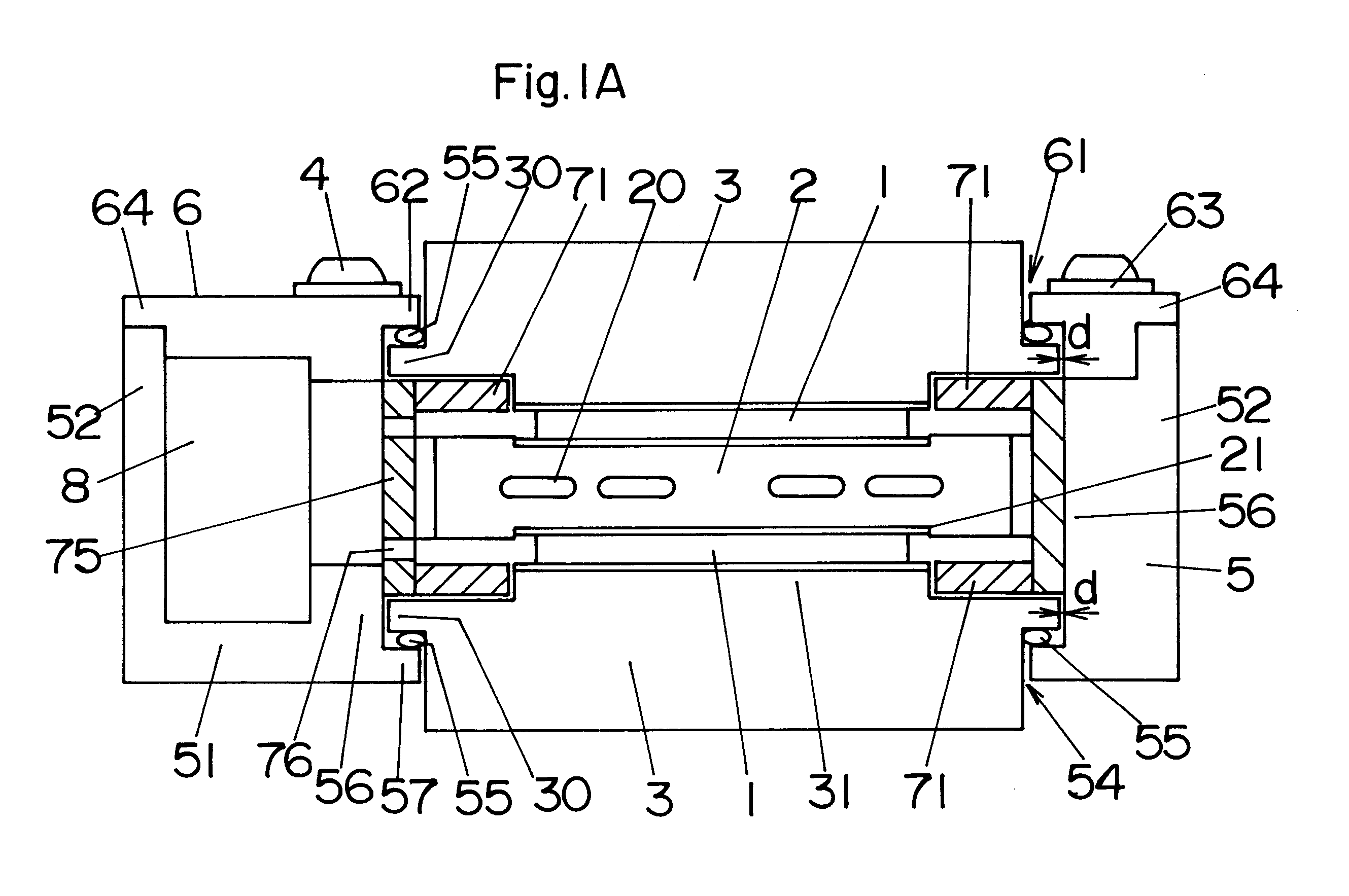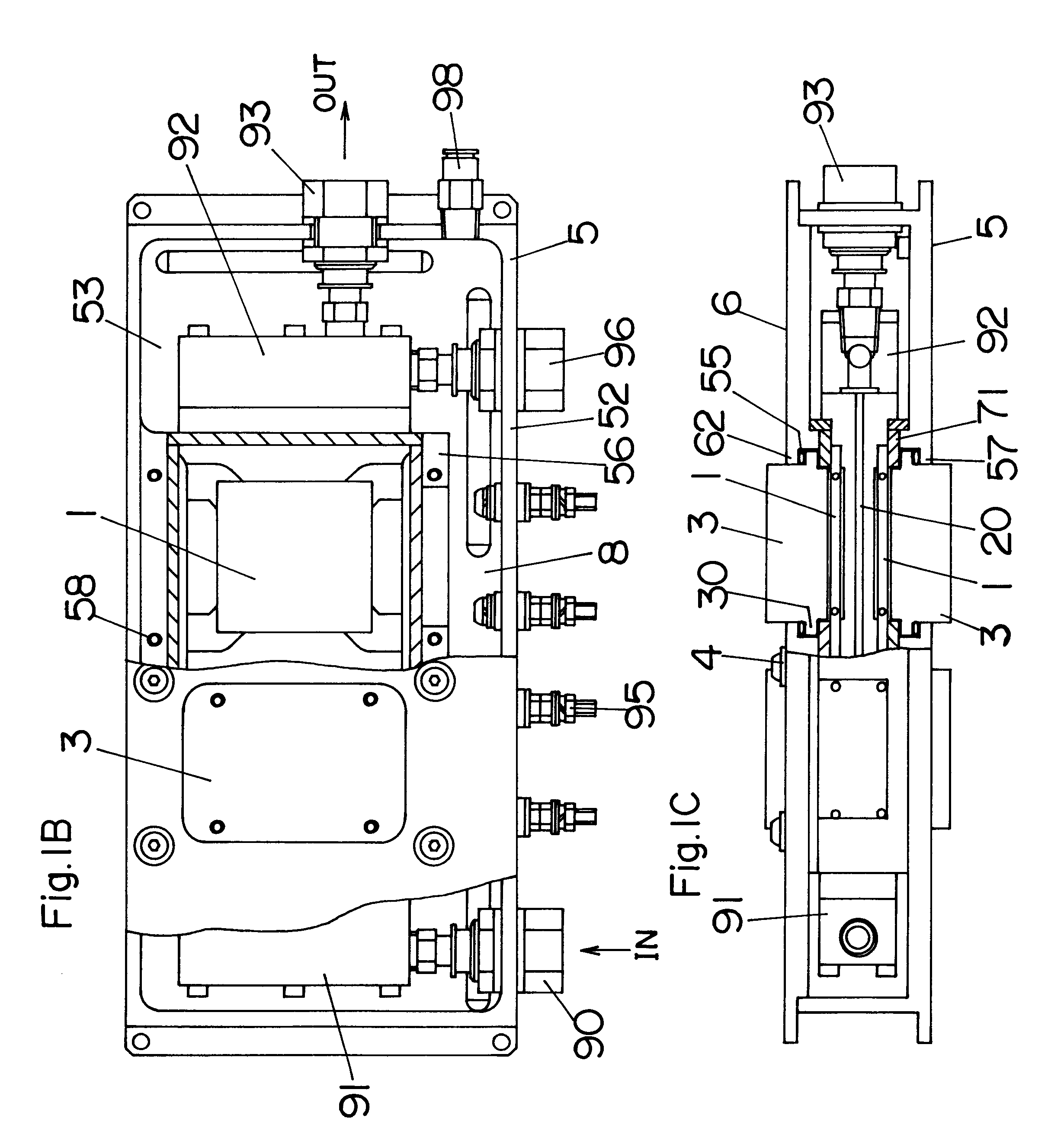Apparatus for controlling temperature of fluid by use of thermoelectric device
a technology of thermoelectric device and fluid, which is applied in the direction of lighting and heating apparatus, machines using electric/magnetic effects, refrigerating machines, etc. it can solve the problems of destroying the ozone layer caused by the constant release into the atmosphere of chlorofluorocarbons (cfcs), and the thermo-module 1 is often broken by the thermal stress
- Summary
- Abstract
- Description
- Claims
- Application Information
AI Technical Summary
Problems solved by technology
Method used
Image
Examples
first embodiment
As shown in FIGS. 1A to 1C, an apparatus for controlling the temperature of a fluid according to a first embodiment of the present invention has two temperature control units in series. Each of the temperature control units comprises a first heat-transfer member 2 having channels 20, through which the fluid flows, a pair of thermo-modules 1 each incorporating a thermoelectric device that is often called Peltier device, and a pair of second heat-transfer members 3 for transferring heat radiated from the thermo-modules 1.
The thermo-module 1 has a structure that N-type and P-type semiconductors are arranged between upper and lower electrodes 10, 11, as shown in FIG. 2, and ceramic plates 15, 16 are placed on the upper and lower electrodes, respectively. Since the principle of the thermo-module has been previously known, its detail explanation is omitted. In brief, when a direct current is supplied to the thermo-module 1 through a lead wire 13, as shown in FIG. 2, it flows from the N-ty...
second embodiment
As shown in FIGS. 6A to 6C, an apparatus for controlling the temperature of a fluid according to a second embodiment of the present invention has four temperature control units in series. Each of the temperature control units is composed of a first heat-transfer member 2A having channels 20A, through which the fluid flows, a single thermo-module 1A incorporating a thermoelectric device that is often called Peltier device, and a single second heat-transfer member 3A for transferring heat radiated from the thermo-modules 1A. In the temperature control unit of the first embodiment, the two thermo-modules 1 are disposed on the opposite surfaces of the first heat-transfer member 2. In this embodiment, the thermo-module 1A is disposed on only one side of the first heat-transfer member 2A. As the thermo-module 1A and the second heat-transfer member 3A, it is possible to use those used in the first embodiment.
As shown in FIGS. 6B and 6C, the first heat-transfer members 2A of the four temper...
third embodiment
As shown in FIGS. 8A to 8C, an apparatus for controlling the temperature of a fluid according to a third embodiment of the present invention has a plurality of temperature control units in series. Each of the temperature control units is substantially the same structure as that of the first embodiment. Therefore, no duplicate explanation to common parts is deemed necessary. The apparatus of this embodiment uses a pair of upper and lower holding frames 5C, coupling member 6C having screw holes 62C, and a sidewall member 7C extending around the temperature control unit and between the holding frames. Each of the holding frames 5C is formed with an aperture 54C, first flange 51C, and a second flange 52C. The numeral 53C designates a screw-hole for the use of a bolt 4C. The coupling member 6C is disposed between the holding frames 5C.
The first flange 51C of the upper holding frame 5C is pressed against a flange 30C of the upper one of second heat-transfer members 3C through a sealing ma...
PUM
 Login to View More
Login to View More Abstract
Description
Claims
Application Information
 Login to View More
Login to View More - R&D
- Intellectual Property
- Life Sciences
- Materials
- Tech Scout
- Unparalleled Data Quality
- Higher Quality Content
- 60% Fewer Hallucinations
Browse by: Latest US Patents, China's latest patents, Technical Efficacy Thesaurus, Application Domain, Technology Topic, Popular Technical Reports.
© 2025 PatSnap. All rights reserved.Legal|Privacy policy|Modern Slavery Act Transparency Statement|Sitemap|About US| Contact US: help@patsnap.com



